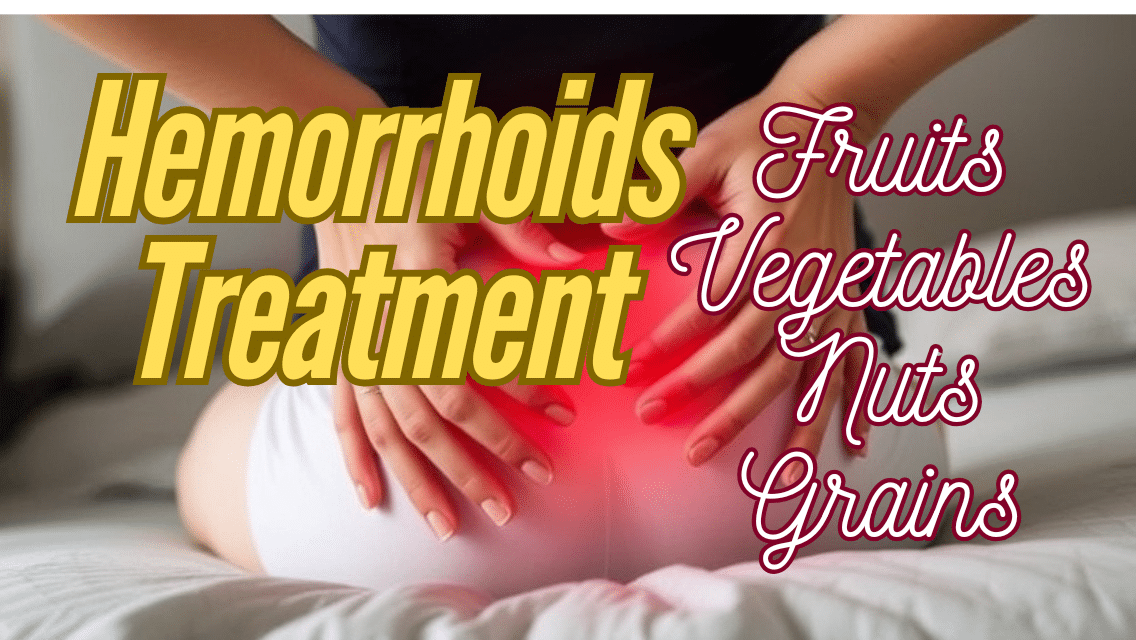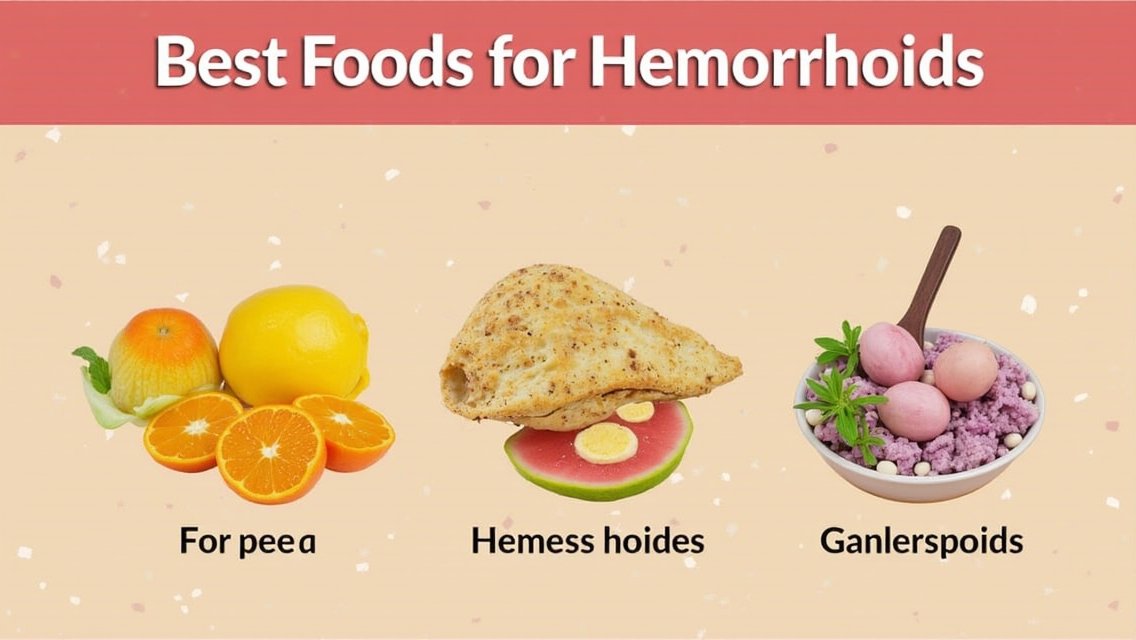May be, it is time for you to go for hemorrhoids treatment.
“Comprehensive Hemorrhoids Treatment Guide for Internal and External Bleeding: Natural Remedies, Medical Options & Prevention Tips”
Discover effective solutions for hemorrhoids treatment to relieve discomfort and stop bleeding hemorrhoids. This comprehensive guide covers internal and external hemorrhoids, offering practical tips on how to manage symptoms and prevent recurrence. Learn about natural remedies, lifestyle changes, over-the-counter options, and medical procedures that work.
Understand the causes of hemorrhoids and explore the best home treatments for relief. Find advice on dealing with bleeding hemorrhoids, preventing irritation, and reducing pain. Whether you’re seeking natural hemorrhoid treatments or considering professional medical options, this post is your go-to resource for healing and comfort.
Hemorrhoids treatment is like any other treatment that we need not to be shameful or worried over it. Suffering from hemorrhoids and experiencing pain out of internal and external bleeding can be an unimaginable and shameful moment in life for anyone. Here you will find information on diagnosis for hemorrhoids treatment for internal and external bleeding.
Hemorrhoids Treatment
You are not only the one who have been suffering by hemorrhoids, rather there are many like you who have been suffering from the same hemorrhoids sickness. They all need hemorrhoids treatment as early as possible. They can also consciously work for hemorrhoids prevention.
If you want to get full knowledge on hemorrhoids treatment you need to get into these topics such as: external hemorrhoids treatment, external hemorrhoids in females, internal hemorrhoids treatment female hemorrhoids, what shrinks hemorrhoids fast, what causes hemorrhoids, hemorrhoids cream, and piles cure in 3 days.
Hemorrhoids treatment is best at any convenience time at home. If you do not know how to practice home remedies for hemorrhoids treatment at home you can learn here basic Home Treatment, Medicines and Remedies for hemorrhoids relief
Hemorrhoids treatment can be successful with diet control. You can find out Best High Fiber Foods for hemorrhoids treatment and avoid worst foods that support hemorrhoids pain.
What is Hemorrhoids?
Hemorrhoids, which is known as piles, are swollen veins in the lower rectum and anus, similar to varicose veins. These swollen veins inside of your rectum or outside of your anus can cause pain, anal itching and rectal bleeding. At this situation they need hemorrhoids treatment for cure and relief. Hemorrhoids are common and can cause discomfort, pain, itching, and bleeding, especially during bowel movements. Once you identify your sickness, you need to go for hemorrhoids treatment as soon as possible. Always it is advisable to know that prevention is better than cure.
Who will Get Hemorrhoids?
Hemorrhoids can occur at any age. However it is more common in adults, particularly those aged 45 to 65. Hemorrhoids increases as people get older because the tissues that support the veins in the rectum and anus can weaken and stretch with age. However hemorrhoids treatment is possible for all with the new medical technology. Certain life stages and conditions, such as pregnancy, can also increase the risk of developing hemorrhoids, making them common in women during and after pregnancy.
These are the common areas when one can get hemorrhoids.
1. At pregnant.
2. Person in higher weight
3. When eating a low-fiber diet.
4. Having chronic constipation or diarrhea.
5. Spending a lot of time sitting on the toilet.
6. Straining while having bowel movements.
7. Regularly lift heavy objects.
Paying attention in all these areas will prevent from it.
What are the Symptoms for Hemorrhoids?
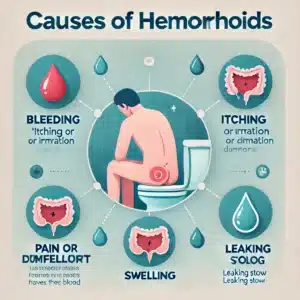
The symptoms of hemorrhoids can vary depending on whether they are internal or external bleeding. When you see symptoms of hemorrhoids, you can go for hemorrhoids treatment as soon as you feel it in your body.
These are the common symptoms of hemorrhoids.
1. Bleeding
Bright red blood on the toilet paper or in the toilet after a bowel movement.
2. Itching or Irritation
Around the anal area, often caused by mucus discharge or swelling.
3. Pain or Discomfort
Especially during bowel movements. External hemorrhoids can cause more pain if a clot forms.
4. Swelling
Around the anus, which can sometimes feel like a lump (external hemorrhoids).
5. Lump or Prolapse
Internal hemorrhoids may prolapse or bulge outside of the anus, causing discomfort or the sensation of a lump.
6. Leaking Stool
In some cases, hemorrhoids can make it difficult to fully close the anus, leading to leakage of stool.
These symptoms can also be linked to other conditions, so it’s important to consult a doctor for an accurate diagnosis and hemorrhoids treatment.
What are the Causes for Hemorrhoids?
Hemorrhoids are caused by increased pressure in the lower rectum, which leads to swelling and inflammation of the veins around the anus. Before you go for hemorrhoid treatment, find out the real cause for hemorrhoids. Here are common causes:
1. Straining During Bowel Movements
Pushing too hard during bowel movements puts pressure on the rectal veins.
2. Chronic Constipation or Diarrhea
Both conditions can lead to prolonged straining and irritation of the anal area.
3. Sitting for Long Periods on the Toilet
This can increase pressure on the rectal veins.
4. Pregnancy
The increased pressure on the pelvic blood vessels and hormonal changes during pregnancy can lead to hemorrhoids.
5. Obesity
Carrying excess weight puts extra pressure on the lower rectum.
6. Low-Fiber Diet
A diet lacking in fiber can lead to constipation, which increases the likelihood of straining.
7. Heavy Lifting
Frequently lifting heavy objects or weights can lead to increased abdominal pressure, contributing to hemorrhoids.
8. Aging
As people age, the tissues that support the rectal veins weaken, increasing the likelihood of hemorrhoids.
9. Anal Intercourse
This can cause irritation and strain in the anal area.
Are there Connections Between Hemorrhoids and Diabetes?
Yes, there can be a connection between hemorrhoids and diabetes, but it is usually indirect. Here’s how they might be related:
1. Increased Risk of Constipation. Diabetes, particularly if not well-managed, can lead to nerve damage, including in the digestive system. This can result in a condition called diabetic neuropathy, which may slow down digestion and lead to constipation. Constipation increases the risk of developing hemorrhoids due to straining during bowel movements. As hemorrhoids treatment you can control diabetes first then automatically you will feel relief from hemorrhoids.
2. Obesity. Obesity is a common risk factor for both diabetes and hemorrhoids. Excess body weight can put additional pressure on the veins in the rectal area, leading to the development of hemorrhoids. It can be cured by hemorrhoids treatment. Obesity is also closely linked to the development of type 2 diabetes.
3. Weakened Blood Vessels. People with diabetes may experience damage to blood vessels over time due to high blood sugar levels. Weakened blood vessels, including those in the rectal area, may be more prone to swelling, potentially contributing to hemorrhoid development. Make sure that you consult a doctor for hemorrhoid treatment.
4. Increased Inflammation. Diabetes is associated with higher levels of inflammation throughout the body. Chronic inflammation can make tissues, including veins in the anal region, more susceptible to swelling and irritation.
Managing diabetes through healthy eating, maintaining a balanced diet high in fiber, staying hydrated, and regular exercise can help reduce the risk of constipation and, consequently, hemorrhoids. Always consult with a healthcare provider for guidance specific to your health situation and hemorrhoids treatment.
How to Prevent Hemorrhoids Before Hemorrhoids Treatment?
Preventing hemorrhoids involves making lifestyle changes that promote healthy bowel habits and reduce pressure on the rectal area. Here are some effective prevention strategies:
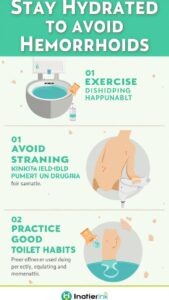
1. Increase Fiber Intake
Eat a diet rich in fruits, vegetables, whole grains, and legumes to help soften stool and promote regular bowel movements. Diet control is the natural form of hemorrhoids treatment.
2. Stay Hydrated
Drink plenty of water throughout the day to help prevent constipation.
3. Exercise Regularly
Engage in physical activity to help stimulate bowel function and reduce pressure on the rectal veins.
4. Avoid Straining During Bowel Movements
If you’re having difficulty, try not to push too hard, and consider using a stool softener or fiber supplement if needed.
5. Don’t Delay Bowel Movements
Respond promptly to the urge to have a bowel movement to prevent constipation and straining.
6. Practice Good Toilet Habits
Avoid sitting on the toilet for extended periods and consider using a footstool to elevate your feet, which can help make bowel movements easier.
7. Maintain a Healthy Weight
Excess weight can increase pressure on the pelvic veins, so maintaining a healthy weight can help reduce the risk.
8. Avoid Heavy Lifting
If you must lift heavy objects, use proper lifting techniques to minimize strain.
9. Limit Alcohol and Caffeine
These can dehydrate you and contribute to constipation, so moderation is key.
10. Consider Regular Check-ups
Regular medical check-ups can help monitor and manage conditions to avoid hemorrhoids.
By adopting these lifestyle changes, you can significantly reduce your risk of developing hemorrhoids. After practicing all those hemorrhoids prevention methods, it you find symptoms of hemorrhoids, then it is better to consult a doctor for hemorrhoids treatment.
Best Food and Beverages for Hemorrhoids Treatment
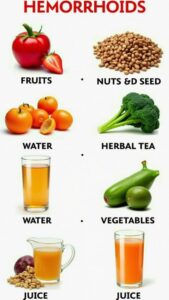
When dealing with hemorrhoids, choosing the right foods and beverages can help alleviate symptoms, promote healing, and prevent further irritation.
If you want to go for hemorrhoids treatment, you need to pay attention of foods and beverages. Here are some of the best options:
1. High-Fiber Foods
Fiber is essential for softening stools and promoting regular bowel movements, which can reduce the strain that worsens it. High-fiber foods become natural hemorrhoids treatment for hemorrhoids.
A. Fruits: Apples, pears, berries, oranges, bananas, and avocados. Eating fruits with the skin on adds extra fiber.
B. Vegetables: Broccoli, Brussels sprouts, carrots, sweet potatoes, spinach, and kale.
C. Whole Grains: Oats, brown rice, whole wheat bread, barley, and quinoa.
D. Legumes: Beans, lentils, chickpeas, and peas are excellent sources of both soluble and insoluble fiber.
E. Nuts and Seeds: Almonds, chia seeds, flaxseeds, and sunflower seeds are good sources of fiber and healthy fats. Fruits, Nuts and Seed, Water, Herbal Tea, Vegetables, Juice
2. Hydrating Beverages
Proper hydration helps keep stools soft and makes them easier to pass, which is crucial for hemorrhoid relief. If you are already suffering from hemorrhoids pain and bleeding, then hemorrhoids treatment is advisable for you right away.
A. Water: Drink plenty of water throughout the day, aiming for at least 8 glasses (64 ounces) daily.
B. Herbal Teas: Chamomile, peppermint, or ginger tea can be soothing and aid digestion without irritating the digestive tract.
C. Coconut Water: A natural source of electrolytes, coconut water can keep you hydrated and help prevent constipation.
D. Vegetable Juices: Freshly made vegetable juices, particularly those with greens, can provide hydration and nutrients without added sugars.
3. Anti-Inflammatory Foods
Certain foods have anti-inflammatory properties that can help reduce the swelling and irritation associated with it.
A. Omega-3 Fatty Acids: Found in fatty fish like salmon, mackerel, and sardines, as well as in flaxseeds and walnuts.
B. Turmeric: A spice known for its anti-inflammatory properties, which can be added to various dishes or taken as a supplement.
C. Berries: Blueberries, strawberries, and blackberries are rich in antioxidants and have anti-inflammatory effects.
D. Ginger: Incorporate fresh ginger into your meals or enjoy it as a tea to reduce inflammation.
4. Soothing Foods
Certain foods can be particularly soothing to the digestive system and help alleviate hemorrhoid symptoms.
A. Yogurt: Contains probiotics that promote healthy digestion and regular bowel movements.
B. Oatmeal: A gentle, fiber-rich breakfast option that’s easy on the digestive system.
C. Bananas: High in fiber and potassium, they help regulate bowel movements without causing irritation.
D. Sweet Potatoes: A nutrient-dense option that is rich in fiber and vitamins, offering a soothing effect.
Foods to Avoid For Hemorrhoids Treatment
While certain foods can help to heal it. Others may be exacerbate symptoms and should be avoided. Hemorrhoids treatment includes certains foods to avoid for speedy recovery.
A. Spicy Foods: Can irritate the digestive tract and worsen hemorrhoid symptoms.
B. Processed Foods: Often low in fiber and high in salt, sugar, and unhealthy fats, which can lead to constipation.
C. Alcohol and Caffeine: Both can dehydrate the body and contribute to constipation.
D. Red Meat: Difficult to digest and may lead to constipation, worsening hemorrhoids.
Conclusion:
A diet rich in fiber, combined with adequate hydration, is considered as hemorrhoids treatment. Focus on whole foods like fruits, vegetables, whole grains, and lean proteins while avoiding processed foods and irritants. Regular consumption of these foods and beverages can make a significant difference in managing and healing process of hemorrhoids treatment.
